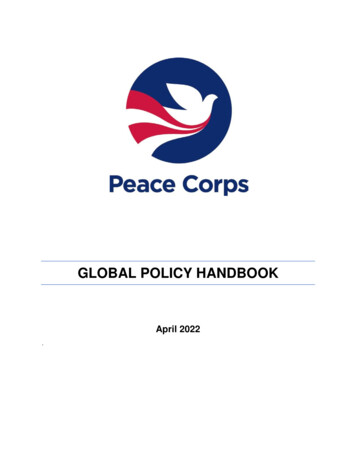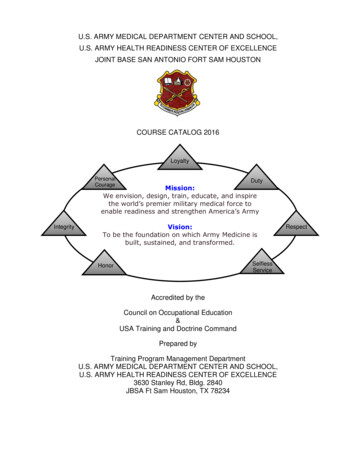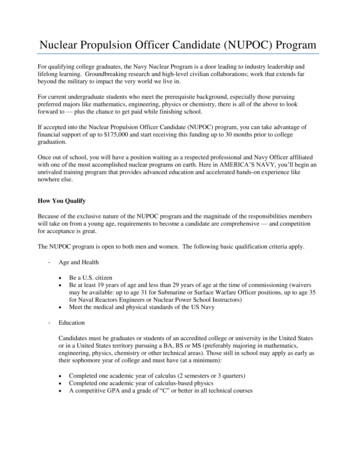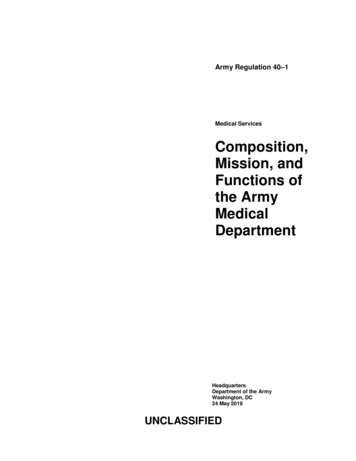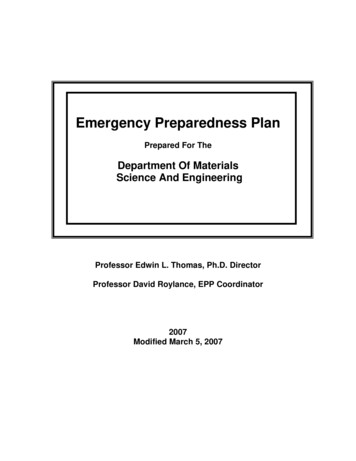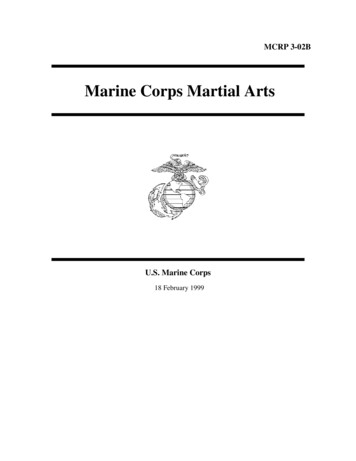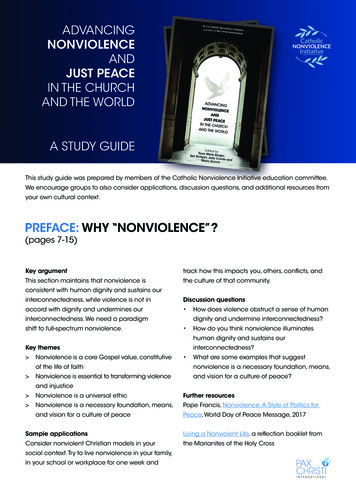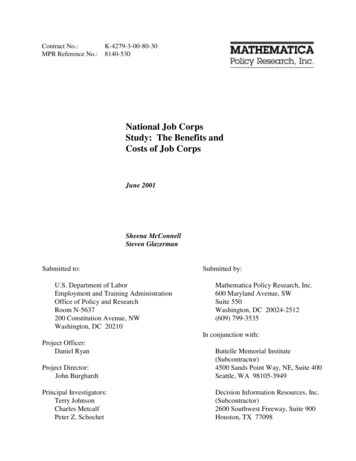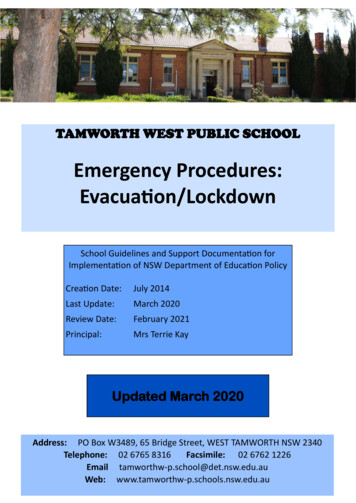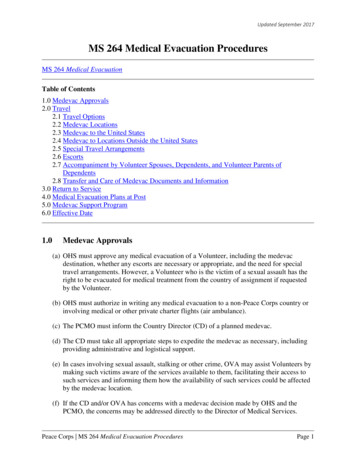
Transcription
Updated September 2017MS 264 Medical Evacuation ProceduresMS 264 Medical EvacuationTable of Contents1.0 Medevac Approvals2.0 Travel2.1 Travel Options2.2 Medevac Locations2.3 Medevac to the United States2.4 Medevac to Locations Outside the United States2.5 Special Travel Arrangements2.6 Escorts2.7 Accompaniment by Volunteer Spouses, Dependents, and Volunteer Parents ofDependents2.8 Transfer and Care of Medevac Documents and Information3.0 Return to Service4.0 Medical Evacuation Plans at Post5.0 Medevac Support Program6.0 Effective Date1.0Medevac Approvals(a) OHS must approve any medical evacuation of a Volunteer, including the medevacdestination, whether any escorts are necessary or appropriate, and the need for specialtravel arrangements. However, a Volunteer who is the victim of a sexual assault has theright to be evacuated for medical treatment from the country of assignment if requestedby the Volunteer.(b) OHS must authorize in writing any medical evacuation to a non-Peace Corps country orinvolving medical or other private charter flights (air ambulance).(c) The PCMO must inform the Country Director (CD) of a planned medevac.(d) The CD must take all appropriate steps to expedite the medevac as necessary, includingproviding administrative and logistical support.(e) In cases involving sexual assault, stalking or other crime, OVA may assist Volunteers bymaking such victims aware of the services available to them, facilitating their access tosuch services and informing them how the availability of such services could be affectedby the medevac location.(f) If the CD and/or OVA has concerns with a medevac decision made by OHS and thePCMO, the concerns may be addressed directly to the Director of Medical Services.Peace Corps MS 264 Medical Evacuation ProceduresPage 1
Updated September 20172.0Travel2.1 Travel OptionsVolunteers may be evacuated via commercial flights air ambulance, military air craft, oroverland transportation, as defined in the post’s medical evacuation plan. Most Volunteers aremedically evacuated on regular commercial airline flights. In a life-threatening emergencyrequiring evacuation, where suitable commercial transportation is not available or adequate, theassistance of other emergency evacuation options may be used, including but not limited to otherFederal agencies. If necessary, the CD must contact the American embassy to expediteemergency evacuation.2.2 Medevac LocationsPeace Corps generally evacuates Volunteers to either the United States or a regional medevaclocation. However, in emergency situations, the Peace Corps may evacuate a Volunteer toanother appropriate location. The selection of an evacuation point will be based on theVolunteer’s medical condition and needs, and the proximity of a medically appropriatefacility. In the case of a Volunteer who is the victim of sexual assault, stalking or other seriouscrime, the PCMO and OHS must also consult with the OVA in determining the medevaclocation.2.3 Medevac to the United StatesMedical evacuees to the United States will generally go either directly to Washington, DC, or tothe Volunteer’s home of record, but may go to another point in the United States, as determinedby OHS in consultation with the PCMO as appropriate.2.4 Medevac to Locations Outside the United States(a) Regional medevac locations are approved by OHS after consideration of the level ofservices available and the post’s ability to support the site as a regional medicalevacuation location. A decision to medically evacuate a Volunteer to an approvedregional medevac location is appropriate when the PCMO (or RMO, as appropriate), withapproval of OHS, determines that the regional location facilities are adequate to treat themedical condition of the Volunteer.(b) In extraordinary circumstances, as determined by OHS, a Volunteer may be medevacedto a non-Peace Corps country. Such a medevac must be authorized in writing by OHS.2.5 Special Travel ArrangementsThe majority of medevaced Volunteers will travel from the post to the medevac location viaeconomy class on a commercial airline. Where the medical condition of the Volunteer requiresspecial arrangements during travel, OHS may approve and authorize the following specialarrangements:(a) Business or first class seating on the airplane;Peace Corps MS 264 Medical Evacuation ProceduresPage 2
Updated September 2017(b) Stretcher or more than one seat;(c) Medications en-route;(d) An escort; and(e) Other medically necessary arrangements.2.6 EscortsThe majority of medevaced Volunteers travel without an escort from the post to the medevaclocation. In some cases, however, it is necessary for an escort to travel with the Volunteer atPeace Corps expense. The PCMO may recommend and OHS must approve the need to appointan escort, whether such an escort must be a medical professional, and the level of care needed forthe Volunteer. A second escort may be selected in unusual circumstances only if determined asnecessary by the PCMO and OMS. As appropriate, the escort may provide clinical care en-route,continuous monitoring for the Volunteer, emotional support, and/or physical assistance. Theescort must be a healthcare professional or a post staff member, except that OHS may determinein rare or special circumstances that a Volunteer or family member should accompany theevacuee at Peace Corps expense.In the case of sexual assault, stalking or other serious crime, the Volunteer must be accompaniedby a Peace Corps staff member, unless declined by the Volunteer.In anticipation of the need for a medical escort for a medevaced Volunteer, all PCMOs mustmaintain active visas for entry into the United States, unless an exception is given fromOMS. Any expenses required to maintain an active visa will be borne by the post.If the PCMO selects a post staff member or another Volunteer as an escort, the PCMO mustobtain the concurrence of the CD so that the post staff and program needs are considered. OHSmust approve the use of a Volunteer as an escort.The PCMO must ensure that the escort:(a) Understands the escort responsibilities;(b) Is aware of the medical support needs of the patient, and is capable of providing thesupport;(c) Hand-carries the medical files and related evacuation documents, and provides thereceiving clinical staff with all necessary information;(d) Physically accompanies the patient from the point of overseas departure to the designateddestination;(e) Understands that the responsibility for the Volunteer remains with the escort until theVolunteer is accepted by a medical facility or by the OHS staff or PCMO at thedestination;Peace Corps MS 264 Medical Evacuation ProceduresPage 3
Updated September 2017(f) Complies with the confidentiality requirements of the Privacy Act, HIPAA, and PeaceCorps confidentiality policies;(g) Is fully briefed and given written instructions concerning airports, hotels, taxis, contacttelephone numbers and any other pertinent information; and(h) In the event of a psychiatric emergency, an escort of the same gender must accompanythe medevaced Volunteer/Trainee.Once the escort has delivered the Volunteer to the appropriate destination, the escort is generallyexpected to return to post. If the escort is another Volunteer or post staff, the escort is allowed amaximum of 72 hours at the evacuation site to recover from the trip before returning to post. Anyadditional leave must be approved by the CD.2.7 Accompaniment by Volunteer Spouses, Dependents, and Volunteer Parents ofDependentsIndependent of whether or not a medical evacuee is provided an escort, the medical evacuee maybe accompanied by his or her Volunteer spouse , if the PCMO, in concurrence with the CD,determines that the Volunteer spouse’s presence is advisable; or may be accompanied by theVolunteer spouse and dependent, if the cause for the evacuation is likely to result in a medicalseparation or death. The PCMO’s determination must be based on such factors as the severity ofthe injury or illness, the need for major surgery, and/or the emotional status of the couple andtheir need for mutual support. In the case of a Volunteer who is the victim of sexual assault,stalking or other serious crime, the PCMO and CD should consult with the OVA.In all cases involving the medical evacuation of a minor child of a Volunteer, one parent mustaccompany the child. If the PCMO determines, in consultation with OMS, that the child’scondition is life-threatening, the PCMO must determine whether both Volunteer parents shouldaccompany the child. In cases where the child’s condition is not life-threatening, and whereaccompaniment by only one Volunteer parent would cause a hardship to the parents (not mereinconvenience), the CD may authorize travel and allowances from post funds for the otherVolunteer parent.2.8 Transfer and Care of Medevac Documents and Information(a) When OMS has authorized a medevac to the United States, post must send the followinginformation to OMS:(1) The evacuee’s name, Volunteer ID, date of birth, and status (Volunteer, Trainee, ordependent), the date the Volunteer entered on duty (EOD), and the projected closeof-service date (COS); the evacuee’s departure and arrival information, including:(i)the airline carrier and flight numbers and airport;(ii)the estimated time of arrival (ETA);Peace Corps MS 264 Medical Evacuation ProceduresPage 4
Updated September 2017(iii) information about an escort or accompanying spouse, dependent, or parentsof dependent, if any;(iv) whether hospitalization is required upon arrival;(v)whether the medical condition requires being met upon arrival with anambulance and attendant;(vi) any special logistical needs required from the Counseling and OutreachUnit/Medevac Support Program; and(2) Whether the situation warrants notification to emergency contacts, and if so, whetherand when they have been notified and what information has been conveyed to them.(b) PCMOs are responsible for ensuring that:(1) The diagnosis of the evacuee is sent to OMS;(2) The CD and the Director of Management Operations (DMO) at post have beennotified of the decision to medevac a Volunteer or dependent and provided the nameof the evacuee, departure information and any special transportation needs;(3) The evacuee or escort hand-carries the evacuee’s health record, including reports andin-country x-rays, in a sealed envelope to the medevac destination;(4) The evacuee has his or her passport with the World Health Organization card, theMedevac Guide, and the health benefits card; and(5) The evacuee and escort are fully briefed and given written instructions concerningairports, hotels, taxis, contact telephone numbers and any other pertinent informationrelated to arrival and travel to the medevac location.(c) CDs are responsible for ensuring that:(1) Each medical evacuee has been given an advance of at least three days per diem forimmediate expenses (see MS 221);(2) Each evacuee or escort hand-carries all appropriate administrative documentation orforms necessary for the medevac and care of the Volunteer or dependent;(3) The applicable Country Desk is informed that a Volunteer is on medevac.(4) If indicated, the local U.S. Embassy has been contacted to expedite U.S.Immigration clearances of the Volunteer and non-U.S. PCMO escort;(5) OHS and the respective Regional Director or Chief of Operations are informedpromptly of any non-medical issues that might affect the return to service by anevacuated Volunteer; andPeace Corps MS 264 Medical Evacuation ProceduresPage 5
Updated September 2017(6) In the case of victims of sexual assault, stalking and other serious crime, OVA isinformed of any non-medical issues that might affect the return to service by anevacuated Volunteer.(d) OHS is responsible for ensuring:(1) The Program Specialist/Medevac Team Lead is informed of the itinerary of allmedevaced Volunteers, as soon as it is made available by post.(2) The Chief of Counseling and Outreach Unit or designee is informed of the itineraryof all Volunteers medevaced for mental health concerns, as soon as it is madeavailable by post.(3) The OVA is informed of the itinerary of all medevaced Volunteers who are victimsof sexual assault, stalking or other serious crime, as soon as it is made available bypost.(4) That the appropriate Regional Director or Chief of Operations has been informed ofOMS’s decision on cases under 2.8(c)(5) above.The OHS staff will provide the PCMO information on the ongoing and final status of theVolunteer. Once final decisions are made, OHS will inform the PCMO of either the Volunteer’stime of arrival (ETA) in country if the Volunteer has been medically cleared, or the terminationdate of a medically separated Volunteer. The PCMO is responsible for keeping the CD apprisedof the ongoing and final status.The staff (PCMO or RMO) at a regional medevac site will routinely provide the Volunteer’sPCMO and OHS staff with information on the status of the Volunteer and, in consultation withOHS, the final decision regarding return to country or date of termination for a medicallyseparated Volunteer. The Volunteer’s PCMO is also responsible for apprising the Volunteer’sCD of this information. In cases of sexual assault, stalking and serious crime, OVA will beresponsible for keeping the CD apprised of the coordinated Peace Corps response with theexception of privileged clinical information.3.0Return to ServiceOHS will determine whether a Volunteer can be medically cleared to return to service or will bemedically separated pursuant to MS 284. In cases of sexual assault, stalking and other seriouscrime, OHS will keep OVA informed.A Volunteer who is medically cleared for further service by OMS will return to post as soon aspossible unless the Volunteer elects to resign or the CD has, pursuant to subsection 2.8 (3)(e),informed OHS of any non-medical issues that might affect the return to service by an evacuatedVolunteer. In consultation with OHS, the Regions will seek to resolve non-medical issues duringthe medevac. In cases where non-medical issues have not been resolved by the time theVolunteer is medically cleared to return to post, the Volunteer will no longer be on medevacstatus and the Region will be responsible for determining the status of the Volunteer. OHS willPeace Corps MS 264 Medical Evacuation ProceduresPage 6
Updated September 2017give the Regions not less than three (3) business days notice before the anticipated end of amedevac. In cases of sexual assault, stalking and other serious crime, the CD or the Region mustconsult with OVA.Medically evacuated Volunteers who have less than ninety days of service remaining willusually be given an advanced completion of service (COS) date. Such a Volunteer will bereturned to post only where the CD determines that the Volunteer’s absence would adverselyaffect the project or Peace Corps’ effectiveness in the host country. In cases of sexual assault,stalking and other serious crime, the CD or the Region must consult with OVA.4.0Medical Action Plans at Post4.1 The Medical Action Plan required by MS 264.3 must comply with TG 385 Medical ActionPlan and include the following:(a) In-country medical facilities and physicians and medical facilities and physicians inneighboring countries that provide regular and specialized services;(b) Local resources that could be used in an emergency;(c) Available transportation (U.S., host country or neighboring country) systems; this shouldinclude information on availability, request procedures and landing field capabilities; and(d) Current State Department regulations and procedures concerning medical evacuations, ifrelevant;4.2 The CD must ensure that all staff members are familiar with Medical Action Plan (MAP). Ata minimum, the CD must:(a) Review and approve the plan annually to ensure the MAP is complete and current in allrespects;(b) Brief all new employees concerning the MAP’s contents;(c) Include responsibilities for Plan preparation in the PCMO position description or in thecontract;(d) Provide key staff (SSM, DMO, CD, PCMO and Medical Secretary/Medical Assistant)with their assignment and responsibilities in the case of a life threatening medicalemergency. Each team member must have a copy of the Medical Action Plan (MAP)with their specific duties highlighted and available to them at all times; and(e) Hold annual drills in the form of a table top exercise as described in TG 385 to ensurethat staff can perform their assignments. The exercise must involve all critical membersof the post team including but not limited to the PCMOs, Medical Secretary/Assistant,CD, SSM and DMO.Peace Corps MS 264 Medical Evacuation ProceduresPage 7
Updated September 20175.0Medevac Support ProgramIt is the responsibility of the Medevac Support Program to ensure that medically evacuatedVolunteers are treated holistically with compassion. The Medevac Support Program providesresources and a support structure that helps Volunteers who are medically evacuated to theUnited States maintain a connection to Peace Corps. The objectives of the Medevac SupportProgram are as follows:(a) Maintain daily communication with OHS staff to confirm arrivals, departures and issueswith medevaced Volunteers to ensure that they are receiving appropriate support whilethey are medevaced in the U.S.(b) Provide a personalized orientation packet for those medevacs who are sent to WashingtonD.C. This packet will have essential ancillary information.(c) Provide written information packets to better inform medevaced Volunteers and theirfamilies (as appropriate) on how to cope with medevac status and more easily transitionback into life in the United States should they be medically separated.(d) Ensure airport pick up for Volunteers who are medevaced to Washington D.C.(e) Arrange for a Peace Corps staff member or representative to meet Volunteers who arevictims of sexual assault, stalking or other serious crime at the airport and escort them tothe hotel.(f) Create a medevac support group at Headquarters to provide additional assistance toVolunteers. Organize a regular meet and greet with medevaced Volunteers andHeadquarters staff.(g) Ensure a welcoming environment by establishing an area in the Headquarters building toaccommodate medevaced Volunteers, such as a Medevac Lounge/Waiting area.(h) Facilitate interactions with Returned Peace Corps Volunteer networks.(i) Inform Country Desk Units when Volunteers are medevaced to Washington D.C. orHome of Record (HOR).(j) Keep medevaced Volunteers informed and updated on Peace Corps news as it pertains tothem, such as emergencies and evacuations (see SOP for emergency procedures formedevaced Volunteers who are located in D.C. area).6.0Effective DateThe effective date is the date of issuance.Peace Corps MS 264 Medical Evacuation ProceduresPage 8
2.3 Medevac to the United States Medical evacuees to the United States will generally go either directly to Washington, DC, or to the Volunteer's home of record, but may go to another point in the United States, as determined by OHS in consultation with the PCMO as appropriate. 2.4 Medevac to Locations Outside the United States
